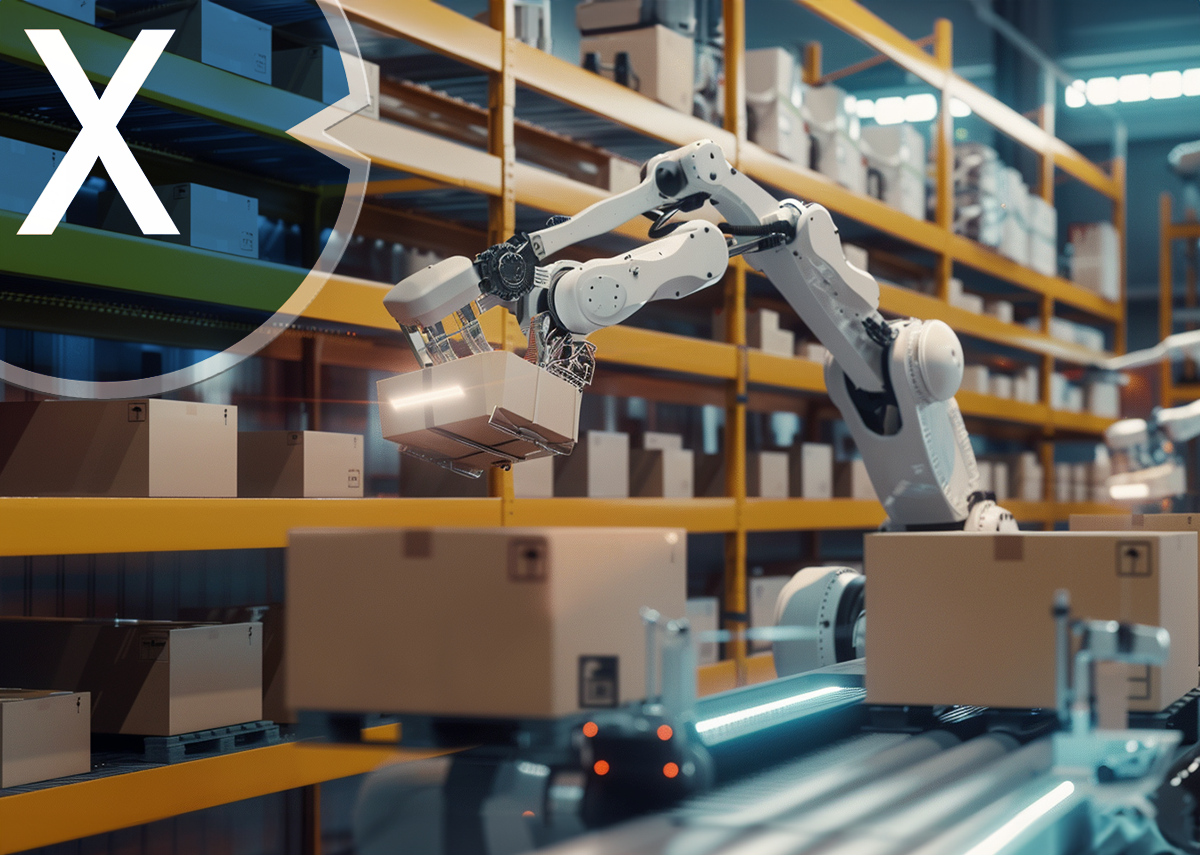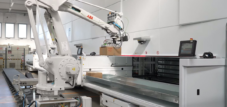
The process of depalletizing and palletizing plays a central role in modern logistics and production with robotics and cobots - Image: Xpert.Digital
📦 The process of depalletizing and palletizing: robots in modern logistics
🤖 The process of depalletizing and palletizing plays a central role in modern logistics and production. Economic considerations and ergonomic requirements, often driven by legal requirements, are increasingly leading to the use of robots in depalletizing and palletizing. In today's industry, these tasks can hardly be carried out efficiently and economically without automatic systems.
🚀 Efficiency through automation
Fully automatic systems for palletizing and depalletizing are now indispensable components of fully automated process chains. They ensure consistent performance and ensure that the efficiency of processes is not affected by external parameters such as staff shortages or human errors. With precise accuracy and high speed, robots handle repetitive tasks that previously required human labor to perform with great physical effort.
📏 Requirements for the systems
The requirements for palletizing and depalletizing systems are diverse. On the one hand, the size and weight of the products play a significant role. On the other hand, such systems must be able to adapt to different environmental conditions. Robot technologies used in layer picking and case picking enable precisely this flexibility. These technologies allow layers or individual boxes to be handled efficiently, significantly speeding up processes and minimizing sources of errors.
💪 Ergonomic advantages
An important aspect when using robots is the ergonomic advantage for employees. Heavy lifting and monotonous movements are no longer necessary, which significantly reduces physical strain. This not only contributes to the health and well-being of the workforce, but also leads to a lower error rate as human labor is used for monitoring and controlling activities.
📜 Legal regulations and standards
In addition to the health benefits, legal regulations and standards play a crucial role in motivating the use of robots for these tasks. Many countries have strict regulations regarding the maximum permissible loads that can be lifted by human workers. Automated systems help companies comply with these regulations while increasing efficiency.
🔗 Integration into existing process chains
The integration of automated palletizing and depalletizing solutions into existing industrial process chains is a key factor for success. Modern systems are designed to be flexible and scalable so that they can be seamlessly integrated into different production environments. By using sensor systems and advanced control software, these robots can independently recognize how the products are arranged on the pallets and react accordingly.
🔧 Technological developments
Technological developments in robotics play a crucial role here. Advances in sensor technology, particularly in image recognition and processing, enable robots to cope with even complex and unforeseen situations. By using artificial intelligence (AI) and machine learning, these systems can continually improve their efficiency and accuracy. Robotics is therefore becoming more and more adaptable and able to take on a wide range of tasks.
💰 Cost efficiency and return on investment
An aspect of automation using robots that should not be underestimated is its economic efficiency. Although the initial investments in such technologies are high, they are amortized through the significant savings in ongoing operating costs. Companies often report a rapid return on investment (ROI) as productivity increases and error rates decrease significantly.
🛡️ Security and reliability
In addition to efficiency and cost-effectiveness, safety also plays an important role. Modern palletizing and depalletizing systems are equipped with extensive safety features that ensure that accidents are avoided. By using collaborative robots that can work in close proximity to people without posing a safety risk, the work environment becomes safer.
🌀 Flexibility and adaptability
Another advantage of automated systems is their ability to adapt to different product specifications and requirements. This is particularly important in industries where the product range changes frequently or there are seasonal fluctuations in demand. Automated systems can respond quickly and efficiently to these changes without the need for extensive retooling.
🔮 The future of palletizing and depalletizing
The future of palletizing and depalletizing will undoubtedly be shaped by further technological advances. As developments in artificial intelligence, the Internet of Things (IoT) and cloud computing continue, systems are expected to become even more intelligent and connected. This will mean that entire logistics chains can be optimized and controlled in real time, further increasing efficiency and reducing costs. The increasing adoption of autonomous mobile robots (AMRs) and automated guided vehicles (AGVs) will also play a key role. These technologies enable even greater flexibility in designing production and logistics chains and contribute to further automation.
🌱 Sustainability
A frequently discussed topic related to automation is sustainability. Automated systems have the potential to reduce waste, optimize energy consumption and be more environmentally friendly overall. Through more precise processes, resources can be used more efficiently and waste can be minimized. This helps to improve the ecological balance of companies.
🌍 International competitiveness
For companies operating in international markets, automation is a crucial factor for competitiveness. By implementing the latest technologies, production and logistics costs can be reduced and the quality of the products can be increased. This leads to a stronger positioning in the market and makes it possible to react quickly and efficiently to customer requirements and wishes.
In summary, automating depalletizing and palletizing processes through the use of robotics brings numerous advantages. These range from increased efficiency and flexibility to improved ergonomics and increased safety and sustainability. Companies that successfully implement these technologies benefit not only from improved productivity, but also from higher competitiveness and more sustainable production.
📣 Similar topics
- 🤖 Robots in modern depalletizing and palletizing
- 💼 Efficiency through automated systems in logistics
- 🏭 Industry 4.0: Revolution through robotics
- 🚚 From manual to automated palletizing
- 🔍 Technological developments and their impact on logistics
- 🌐 Global competitiveness through automatic systems
- 🌱 Sustainability in logistics: resource efficiency through robots
- 🔧 Flexibility and adaptability in modern production
- 🔒 Safety aspects in automated palletizing
- 💰 Economic efficiency and ROI: Advantages of automated systems
#️⃣ Hashtags: #Robots #Automation #Logistics #Efficiency #Sustainability
Xpert partner in warehouse planning and construction
Xpert.Plus warehouse optimization - high-bay warehouses such as pallet warehouses consulting and planning
We are there for you - advice - planning - implementation - project management
☑️ Smart City & Factory: Industry expert for energetic 5G buildings and halls as well as advice and installation of solar systems
☑️ Xpert.Plus - logistics consulting and logistics optimization
☑️ Industry expert, here with his own Xpert.Digital Industry Hub with over 2,500 specialist articles
I would be happy to serve as your personal advisor.
You can contact me by filling out the contact form below or simply call me on +49 89 89 674 804 (Munich) .
I'm looking forward to our joint project.
Xpert.Digital - Konrad Wolfenstein
Xpert.Digital is a hub for industry with a focus on digitalization, mechanical engineering, logistics/intralogistics and photovoltaics.
With our 360° business development solution, we support well-known companies from new business to after sales.
Market intelligence, smarketing, marketing automation, content development, PR, mail campaigns, personalized social media and lead nurturing are part of our digital tools.
You can find out more at: www.xpert.digital - www.xpert.solar - www.xpert.plus

